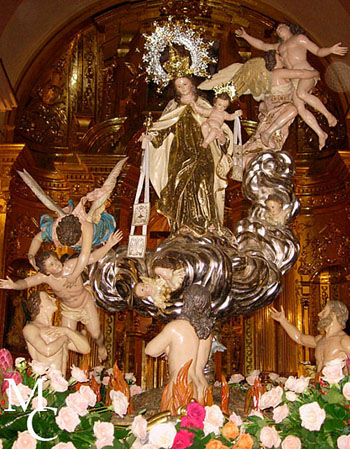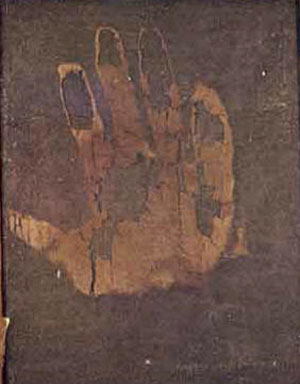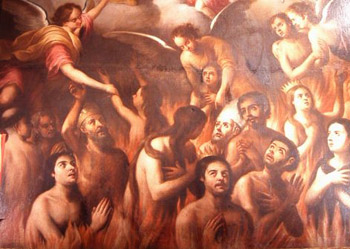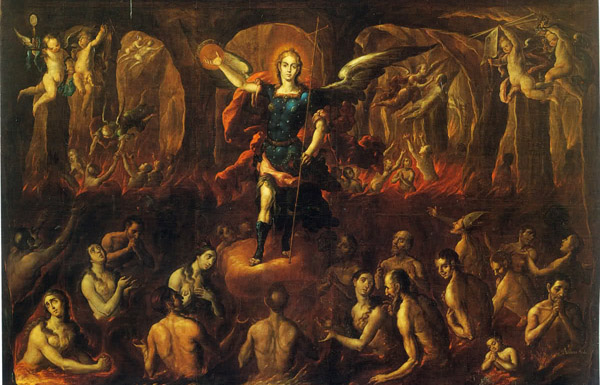Faith under Attack
 |
 |
 |
 |
 |
 |
 |
The Physical Suffering of Purgatory
In his classic work Purgatory Explained, Fr. F.X. Schouppe states that "the Church proposes two truths clearly defined as dogmas of Faith: First, that there is a
Purgatory; Second, that the souls which are in Purgatory may be assisted by the suffrages of the faithful, especially by the Holy Sacrifice of the Mass" (p. 7).
As regards other questions, such as where is the place, the duration and nature of the sufferings, and the number of souls detained there, the Church does not define, but relies mainly upon the great theologians and mystics to explain these mysteries as much as they can be understood by our human intelligence.

In the Basilica of Beniajan, Our Lady of Mount Carmel offers relief to the Poor Souls
My experience has been that, even among Traditionalists, there are those who would prefer to go no further than this because they consider that "the rest is just speculation." This would seem to represent a practical denial of Purgatory, because it weakens, in practice, one’s understanding of just how much the souls in Purgatory suffer, which can only negatively influence how much one actually does for the Suffering Souls, as those in Purgatory are normally referred to by the Church.
I believe that such a position is flawed and it reminds me of those who accept the Fatima apparitions in 1917 as historical because the Church has ruled that they are, but then do not accept the heart of the message of Fatima because they consider that "the rest is just speculation." Yet, just as the Consecration of Russia is delayed no doubt because, as Our Lady once complained to Sister Lucy, “Both the good and the bad ignore my message," so many souls are detained in Purgatory longer than necessary for lack of assistance from otherwise good Catholics.
I believe in both cases - the denial of Purgatory as well as the message of Our Lady of Fatima - there is good evidence to refute these doubts. I will focus primarily on how this relates to Purgatory and limit my discussion on Fatima to a minimum, only by way of parallels.
Some people have difficulty accepting the physical nature of the sufferings in Purgatory. Indeed, it seems to them impossible that such sufferings could involve real, and not simply symbolic, fire. This is because the souls in Purgatory are mere spirits and, therefore, do not have physical bodies. Without bodies, they say, nothing material should be able to touch them or cause them harm.
Various manifestations of souls from Purgatory to saints and mystics, however, prove beyond reasonable doubt that the physical nature of the suffering in Purgatory is real and it is much more intense than anything one can imagine in this world.
A visible reminder for the living
Fr. Shouppe relates that Teresa Gesta, a religious of the Franciscan Sisters in Foligno, Italy, who had served many years as a mistress of novices and was a model of fervor and charity, died suddenly on November 4, 1859, of a stroke of apoplexy. Twelve days later, the soul of Teresa appeared to Sister Anna Felicia in the sacristy of the same Convent. Sister Felicia described it:
"Then the room was filled with a thick smoke, and the spirit of Sister Teresa appeared, moving towards the door and gliding along by the wall. Having reached the door, she cried aloud, ‘Behold a proof of the mercy of God.’

Mark of the hand of Sr. Teresa Gesta - From the Franciscan Sisters of the Cross in Foligna
“Saying these words, she struck the upper panel of the door and there left the print of her right hand, burnt in the wood as with a red-hot iron. She, then, disappeared." (ibid, p. 55)
Because of this apparition, Teresa Gesta’s body was exhumed, and the hand of the deceased, remarkable for its especially small size, fit perfectly into the impression mark. All of this is well documented. If one were to visit that Convent’s chapel today, he would find that very handprint on the upper panel of the door.
Such a demonstration should help alleviate the skepticism of those who find such stories to be "fantastic" or even "fanatical" and, therefore, not worthy of belief. Since this apparition, as well as other visitations of suffering souls, took place in the 19th century, this should counter the tendency to view these stories as "medieval" or something out of the so called “dark” ages.
God sends us such proofs of His justice to counter the skepticism that leads, not just those outside the Church but even otherwise good Catholics within, to consider these divine manifestations unpalatable to modern ears. Our Lord could rightly say of these people what was stated earlier concerning what Our Lady related to Sister Lucy sometime after the Fatima apparitions, "Both the good and the bad ignore my message."
Why did the deceased Sister Gesta speak about the mercy of God in her great suffering, demonstrated by the vivid and terrifying burn mark left on the door by her hand? I believe that the sign she left behind was, in fact, a mercy, a warning to us of what awaits those of us who are not prepared at death to enter directly into the presence of God.
As Fr. Schouppe observed, "In giving us a warning of this kind, God shows us a great mercy. He urges us, in the most efficacious manner, to assist the poor suffering souls, and to be vigilant in our regard." (ibid, p.57)
This example is not unique. Fr. Schouppe reports many such incidents, and I recommend my reader to look for them in his book.
An encouragement to offer relief
For persons who are afraid of the justice of God and can become disheartened rather than encouraged by these examples, I believe they could learn something from the example of the three children at Fatima who were shown Hell "where the souls of poor sinners go." Far from being discouraged at what they saw, they redoubled their efforts to make sacrifices so that sinners could obtain the grace of perfect contrition before death and avoid both the eternal flames of Hell and the transitory flames of Purgatory.

Souls in Purgatory receiving relief
Incidentally, Sister Lucy revealed that the souls that she, Francisco and Jacinta saw in Hell were burning from flames that seemed to come from within them. If such is what the three children saw concerning the souls in Hell who are as yet without their bodies, then it should be no problem to accept that the same can be said for the souls in Purgatory.
While these stories of Purgatory may not impress us as strongly as did the actual apparition of Hell that Lucia, Jacinta, and Francisco saw, it can still inspire us to do more for the Poor Souls to relieve them from the fiery torment and help them leave it as quickly as possible.
We should not become discouraged, thinking, "Well, if that is the case with that holy Sister, then there is no hope for the likes of me." We must not read these stories making too close a connection with ourselves. When reading accounts of the deceased, it is prudent to recall that, no matter the similarities to our lives in the details of why this soul or that soul is in Purgatory, we are only getting part of the story.
It is the whole life of the person that is the subject of one's Particular Judgment, which includes not just virtues and vices, but circumstances of upbringing, education and any number of other factors that have played a part in making someone what he is at the Judgment.
Therefore, it is important that we take from these stories what they are meant to instill: an increase in charity and devotion towards the Suffering Souls, and not a morbid curiosity or exact idea of what our own particular judgments will be.


Posted November 9, 2011
As regards other questions, such as where is the place, the duration and nature of the sufferings, and the number of souls detained there, the Church does not define, but relies mainly upon the great theologians and mystics to explain these mysteries as much as they can be understood by our human intelligence.

In the Basilica of Beniajan, Our Lady of Mount Carmel offers relief to the Poor Souls
I believe that such a position is flawed and it reminds me of those who accept the Fatima apparitions in 1917 as historical because the Church has ruled that they are, but then do not accept the heart of the message of Fatima because they consider that "the rest is just speculation." Yet, just as the Consecration of Russia is delayed no doubt because, as Our Lady once complained to Sister Lucy, “Both the good and the bad ignore my message," so many souls are detained in Purgatory longer than necessary for lack of assistance from otherwise good Catholics.
I believe in both cases - the denial of Purgatory as well as the message of Our Lady of Fatima - there is good evidence to refute these doubts. I will focus primarily on how this relates to Purgatory and limit my discussion on Fatima to a minimum, only by way of parallels.
Some people have difficulty accepting the physical nature of the sufferings in Purgatory. Indeed, it seems to them impossible that such sufferings could involve real, and not simply symbolic, fire. This is because the souls in Purgatory are mere spirits and, therefore, do not have physical bodies. Without bodies, they say, nothing material should be able to touch them or cause them harm.
Various manifestations of souls from Purgatory to saints and mystics, however, prove beyond reasonable doubt that the physical nature of the suffering in Purgatory is real and it is much more intense than anything one can imagine in this world.
A visible reminder for the living
Fr. Shouppe relates that Teresa Gesta, a religious of the Franciscan Sisters in Foligno, Italy, who had served many years as a mistress of novices and was a model of fervor and charity, died suddenly on November 4, 1859, of a stroke of apoplexy. Twelve days later, the soul of Teresa appeared to Sister Anna Felicia in the sacristy of the same Convent. Sister Felicia described it:
"Then the room was filled with a thick smoke, and the spirit of Sister Teresa appeared, moving towards the door and gliding along by the wall. Having reached the door, she cried aloud, ‘Behold a proof of the mercy of God.’

Mark of the hand of Sr. Teresa Gesta - From the Franciscan Sisters of the Cross in Foligna
Because of this apparition, Teresa Gesta’s body was exhumed, and the hand of the deceased, remarkable for its especially small size, fit perfectly into the impression mark. All of this is well documented. If one were to visit that Convent’s chapel today, he would find that very handprint on the upper panel of the door.
Such a demonstration should help alleviate the skepticism of those who find such stories to be "fantastic" or even "fanatical" and, therefore, not worthy of belief. Since this apparition, as well as other visitations of suffering souls, took place in the 19th century, this should counter the tendency to view these stories as "medieval" or something out of the so called “dark” ages.
God sends us such proofs of His justice to counter the skepticism that leads, not just those outside the Church but even otherwise good Catholics within, to consider these divine manifestations unpalatable to modern ears. Our Lord could rightly say of these people what was stated earlier concerning what Our Lady related to Sister Lucy sometime after the Fatima apparitions, "Both the good and the bad ignore my message."
Why did the deceased Sister Gesta speak about the mercy of God in her great suffering, demonstrated by the vivid and terrifying burn mark left on the door by her hand? I believe that the sign she left behind was, in fact, a mercy, a warning to us of what awaits those of us who are not prepared at death to enter directly into the presence of God.
As Fr. Schouppe observed, "In giving us a warning of this kind, God shows us a great mercy. He urges us, in the most efficacious manner, to assist the poor suffering souls, and to be vigilant in our regard." (ibid, p.57)
This example is not unique. Fr. Schouppe reports many such incidents, and I recommend my reader to look for them in his book.
An encouragement to offer relief
For persons who are afraid of the justice of God and can become disheartened rather than encouraged by these examples, I believe they could learn something from the example of the three children at Fatima who were shown Hell "where the souls of poor sinners go." Far from being discouraged at what they saw, they redoubled their efforts to make sacrifices so that sinners could obtain the grace of perfect contrition before death and avoid both the eternal flames of Hell and the transitory flames of Purgatory.

Souls in Purgatory receiving relief
While these stories of Purgatory may not impress us as strongly as did the actual apparition of Hell that Lucia, Jacinta, and Francisco saw, it can still inspire us to do more for the Poor Souls to relieve them from the fiery torment and help them leave it as quickly as possible.
We should not become discouraged, thinking, "Well, if that is the case with that holy Sister, then there is no hope for the likes of me." We must not read these stories making too close a connection with ourselves. When reading accounts of the deceased, it is prudent to recall that, no matter the similarities to our lives in the details of why this soul or that soul is in Purgatory, we are only getting part of the story.
It is the whole life of the person that is the subject of one's Particular Judgment, which includes not just virtues and vices, but circumstances of upbringing, education and any number of other factors that have played a part in making someone what he is at the Judgment.
Therefore, it is important that we take from these stories what they are meant to instill: an increase in charity and devotion towards the Suffering Souls, and not a morbid curiosity or exact idea of what our own particular judgments will be.


Posted November 9, 2011
______________________
______________________





